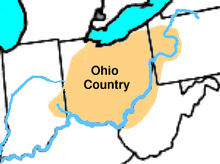Ohio Company

The Ohio Company, formally known as the Ohio Company of Virginia, was a land speculation company organized for the colonization of the Ohio Country. The activities of the company helped to provoke the outbreak of the French and Indian War.
Formation
In the mid 18th century, many within the British Empire viewed the Ohio River Valley, a region west of the Appalachian Mountains thinly populated by American Indians, as a source of potential wealth. In the 1740s, British and Irish businessmen such as George Croghan and William Trent were moving into the area and competing with French merchants in the lucrative fur trade. Land speculators looked to the Ohio Country as a place where lands might be acquired and then resold to immigrants.
In 1747, a number of influential men organized the Ohio Company of Virginia in order to capitalize on these opportunities. The Ohio Company was composed of Virginians, including Thomas Lee as president, Nathaniel Chapman as treasurer (1709 - 1760)[1], John Mercer as the company's secretary and general counsel, John's son George Mercer as the company's agent to England, two of George Washington's brothers, Lawrence Washington (who succeeded to the management upon the death of Lee) and Augustine Washington, Jr., as well as Englishmen, including the Duke of Bedford, Virginia Governor Robert Dinwiddie, and John Hanbury, a wealthy London merchant. A rival group of land speculators from Virginia, the Loyal Company, was organized about the same time, and included influential Virginians such as Thomas Walker and Peter Jefferson (father of Thomas Jefferson).
In 1748, the British Crown approved the Ohio Company's petition for a grant of 200,000 acres (800 km²) near the "forks" of the Ohio River (present Pittsburgh, Pennsylvania). In July 1749, the governor and council of Virginia made the grant on the condition that the company would, within seven years, settle 100 families in the area and erect a fort to protect both them and the British claim on the land. A secondary purpose of this settlement was to establish a regular trade with the local Native Americans, necessary in order to maintain friendly relations.
French and Indian War
In 1750, the Ohio Company hired Christopher Gist, a skillful woodsman and surveyor, to explore the Ohio Valley in order to identify lands for potential settlement. Gist travelled as far west as the Miami Indian village of Pickawillany (near present Piqua, Ohio). Upon the basis of his report, the Ohio Company settled in an area in Western Pennsylvania and present-day West Virginia. In 1752 the company had a pathway blazed between the small fortified posts at Wills Creek (Cumberland, Maryland), and at Redstone Creek (Brownsville, Pennsylvania), which it had established in 1750.
The Ohio Valley was also claimed by France, however, as it was nominally part of the vast territory of New France. The French were not pleased to hear of British activity in the region. The French were very interested in the land, because they believed the milder climates and more fertile soil would prove more beckoning to French settlers than the cold winters and barren soil of French Canada. Additionally, the Ohio River watershed provided a vital link between Canada and French Louisiana. To forestall British expansion, in 1753 the French began constructing a series of forts in the Ohio Valley. Robert Dinwiddie, governor of Virginia as well as a shareholder of the Ohio Company, responded by sending a military unit under the command of George Washington to the region, which led to the outbreak of the French and Indian War. The war and its sequel, Pontiac's Rebellion, prevented the Ohio Company from fulfilling its obligation to establish settlements.
Grand Ohio Company

Ultimately, the Ohio Company was merged into the Grand Ohio Company, also known as the Walpole Company or the Vandalia Company, an organization in which Benjamin Franklin was interested. In 1772, the Grand Ohio Company received from the British government a grant of a large tract lying along the southern bank of the Ohio as far west as the mouth of the Scioto River. A colony to be called "Vandalia" was planned. However, the outbreak of the American Revolutionary War interrupted colonization and nothing was accomplished.
References
- Abernethy, Thomas Perkins. Western Lands and the American Revolution. New York: Russell & Russell, 1959.
- Bailey, Kenneth P. The Ohio Company of Virginia and the Westward Movement, 1748–1792. Originally published 1939. Reprinted Lewisburg: Wennawoods Publishing, 2000. ISBN 1-889037-25-7.
- James, Alfred Procter, The Ohio Company: Its Inner History. Pittsburgh: University of Pittsburgh Press, 1959.
- Mulkearn, Lois, ed. George Mercer Papers Relating to the Ohio Company of Virginia. Pittsburgh: University of Pittsburgh Press, 1954. Collection of many original documents, including Christopher Gist's journal.
- This article incorporates text from a publication now in the public domain: Chisholm, Hugh, ed. (1911). Encyclopædia Britannica (11th ed.). Cambridge University Press.
{{cite encyclopedia}}: Missing or empty|title=(help)
